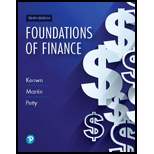
Foundations Of Finance
10th Edition
ISBN: 9780134897264
Author: KEOWN, Arthur J., Martin, John D., PETTY, J. William
Publisher: Pearson,
expand_more
expand_more
format_list_bulleted
Concept explainers
Question
Chapter 2, Problem 11SP
Summary Introduction
To determine: The nominal rate of interest on treasury bonds maturing 0-1 year,1-2 years,2-3 years and 3-4 years.
Expert Solution & Answer
Want to see the full answer?
Check out a sample textbook solution
Students have asked these similar questions
If you want $15,000 in 5 years and can earn 8% annually, how much must you invest now?A) $10,206.38B) $11,022.32C) $12,030.12D) $9,875.00
A loan of $20,000 is to be repaid in 4 equal annual installments at 5% interest. What is the annual payment (rounded)?A) $5,000B) $5,681C) $5,641D) $6,000
If you want $15,000 in 5 years and can earn 8% annually, how much must you invest now?A) $10,206.38B) $11,022.32C) $12,030.12D) $9,875.00need help
Chapter 2 Solutions
Foundations Of Finance
Ch. 2 - Prob. 1RQCh. 2 - Prob. 2RQCh. 2 - Prob. 3RQCh. 2 - Prob. 4RQCh. 2 - Prob. 5RQCh. 2 - Prob. 6RQCh. 2 - Prob. 7RQCh. 2 - Prob. 8RQCh. 2 - Prob. 9RQCh. 2 - Prob. 10RQ
Ch. 2 - Prob. 11RQCh. 2 - Prob. 12RQCh. 2 - Prob. 13RQCh. 2 - Prob. 14RQCh. 2 - Prob. 15RQCh. 2 - Prob. 1SPCh. 2 - Prob. 2SPCh. 2 - Prob. 3SPCh. 2 - Prob. 4SPCh. 2 - Prob. 5SPCh. 2 - Prob. 6SPCh. 2 - Prob. 7SPCh. 2 - Prob. 8SPCh. 2 - Prob. 9SPCh. 2 - Prob. 10SPCh. 2 - Prob. 11SPCh. 2 - (Interest rate determination) Youre looking at...Ch. 2 - Prob. 13SPCh. 2 - (Yield curve) If yields on Treasury securities...Ch. 2 - (Unbiased expectations theory) Currently you have...Ch. 2 - Prob. 2MCCh. 2 - Prob. 3MCCh. 2 - Prob. 4MCCh. 2 - Prob. 5MC
Knowledge Booster
Learn more about
Need a deep-dive on the concept behind this application? Look no further. Learn more about this topic, finance and related others by exploring similar questions and additional content below.Similar questions
- A firm’s cost of equity is 12%, and its expected dividend next year is $1.20. If its stock sells for $15, what is the implied growth rate?A) 4%B) 3%C) 2%D) 1%arrow_forwardYou buy a stock for $40 and sell it a year later for $46 after receiving a $2 dividend. What is your total return?Help!arrow_forwardYou buy a stock for $40 and sell it a year later for $46 after receiving a $2 dividend. What is your total return?A) 10%B) 15%C) 20%D) 25% please explaarrow_forward
- You buy a stock for $40 and sell it a year later for $46 after receiving a $2 dividend. What is your total return?A) 10%B) 15%C) 20%D) 25% need helparrow_forwardIf a company's net income is $300,000 and shares outstanding are 150,000, what is EPS? no ai ..???arrow_forwardIf you invest $5,000 at an annual interest rate of 6% compounded annually, how much will you have after 3 years?A) $5,900B) $5,956.80C) $5,637.20D) $5,946.72need help!!arrow_forward
- You buy a stock for $40 and sell it a year later for $46 after receiving a $2 dividend. What is your total return?A) 10%B) 15%C) 20%D) 25%arrow_forwardIf you invest $5,000 at an annual interest rate of 6% compounded annually, how much will you have after 3 years?A) $5,900B) $5,956.80C) $5,637.20D) $5,946.72arrow_forwardGive me correctly answer gpt....???arrow_forward
- What is the effective annual interest rate for a savings account with nominal rate 5% compounded quarterly? write solution..???arrow_forwardCalculate the annual interest payment for a bond with face value $1,000 and coupon rate 7%. no ai..???arrow_forwardno ai ..,,???A company has fixed costs $30,000, variable costs $10/unit, and sells products at $20/unit. What is the break-even point?arrow_forward
arrow_back_ios
SEE MORE QUESTIONS
arrow_forward_ios
Recommended textbooks for you
- Principles of Accounting Volume 1AccountingISBN:9781947172685Author:OpenStaxPublisher:OpenStax College

Principles of Accounting Volume 1
Accounting
ISBN:9781947172685
Author:OpenStax
Publisher:OpenStax College
The U.S. Treasury Markets Explained | Office Hours with Gary Gensler; Author: U.S. Securities and Exchange Commission;https://www.youtube.com/watch?v=uKXZSzY2ZbA;License: Standard Youtube License